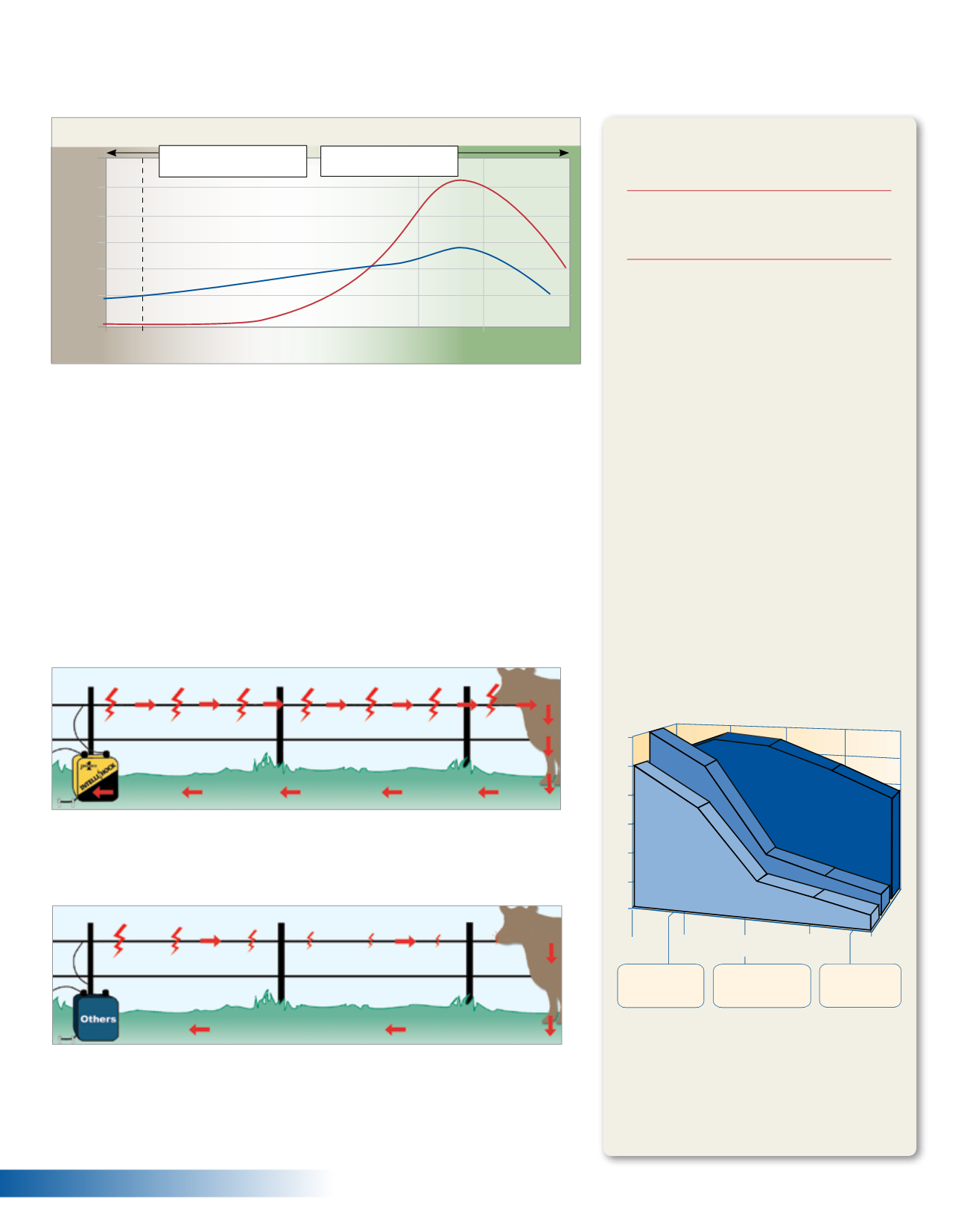
Wide
vs
low
impedance output curves
6
5
4
3
2
1
0
Output in joules
5,000
2,000
1,000
500
50
drier soils, brown grass
& lighter (in weight) species
moist soils, green grass
& heavier species
Fence resistance in ohms (
Ω
)
low
wide
3
2
1
0
200
ohms
500
ohms
2000
ohms
3500
ohms
5000
ohms
Energy output
in joules
6
5
4
USA 10.9
Joule Unit
NZD 7.5
Joule Unit
IntelliShock 506,
6.5 Joule Unit
2 miles of
weed-laden multi-
wire permanent
sheep fence.
Typical single-
strand cattle
fence when grass
is green.
Cattle fence
when the grass
is brown.
82 ENERGIZERS & SOLAR PANELS
www.premier1supplies.com• 1-800-282-6631
Why animals respect wide-impedance energizers!
IntelliShock and Kube energizers
Wide-impedance energizers are able to deliver high-pulse energy levels and high voltages
through
a wider range of fence situations—including those with high total fence circuit resistance due to
inferior polywire/netting; dry, sandy, rocky soils; dry, brown grass; and fewer ground rods.
Animals
have greater respect for and fear of such fences when energized by wide-impedance units.
Most low-impedance energizers
Illustrates how the joules of pulse energy at the end of the fence (and thus the potential pain
available to animals) drop as the total resistance of the fence circuit increases—due to wet soils
becoming dry, reliance upon stainless steel polywire and tape fences, or fencing across sandy/rocky
soils. Low-impedance energizers deliver high pain potentials when the resistance is low
(hence their
well-deserved reputation for working well when the soil is moist and the grass is green),
but much
less as the combined resistance of the soil, animal and wire rises.
Energizer Impedance—wide vs low?
1.
An energizer’s output is not a
constant!
The stated number on
the outside of the box is a
peak.
It’s never more than stated and
almost always much less.
2. The curve is important. The chart
above has 2 energizer output curves
in joules. One is a wide-impedance
unit with 2.7 joule peak output.
The other is a low-impedance
unit with 5.2 joules peak output.
3.
Low-impedance units excel when
the soil is moist, the grass is green,
the animal is a good conductor, and
there are plenty of ground rods.
Wide vs High vs Low
impedance energizers
Impedance is similar to resistance. For energizers
it means the level of ohms (resistance) that
matches an energizer’s peak output. If low ohms
then it’s a low-impedance energizer, etc.
The first fence chargers (50 years ago)
were high-impedance units.
Their maximum output (never very
much) occurred when the fence was
weed-free. They could cope with drier
soils but
their effectiveness disappeared
when a few green weeds touched the fence.
Most were too small in energy output/
pulse to be effective against difficult-to-
contain animals (sheep, goats, chickens).
The next generation was low-
impedance energizers. They coped well
with high weed contact but not with dry
soils or poor conductors.
They work best against low-resistance
animals (cattle, horses, pigs) standing on
moist soils.
Wide-impedance
is Premier’s term for
energizers that perform well in
both
dry
and wet situations.
In dry soils or with animals of high
resistance (goats, wildlife and poultry),
wide-impedance units outperform low-
impedance units of similar output.
4.
Wide-impedance units excel when
the total resistance is higher—
from
brown grass, dry soil (but
not arid), the animal is not a good
conductor or the total ground rod
length is less per joule of output.
5. The higher an energizer’s peak
joule output is at 500
Ω
,
the more
likely it will be effective when
there is high green-weed contact
on the wires close to the ground.
6. The higher an energizer’s output
in joules at 5000
Ω
,
the more likely
it is to be effective when the soil
becomes dry.
This graph compares 2 low-impedance
units with a wide-impedance energizer
—
IntelliShock 506.
• Note when each excelled.
• Note also that the larger low-impedance
unit did better than its low-impedance
little brother in all conditions.









